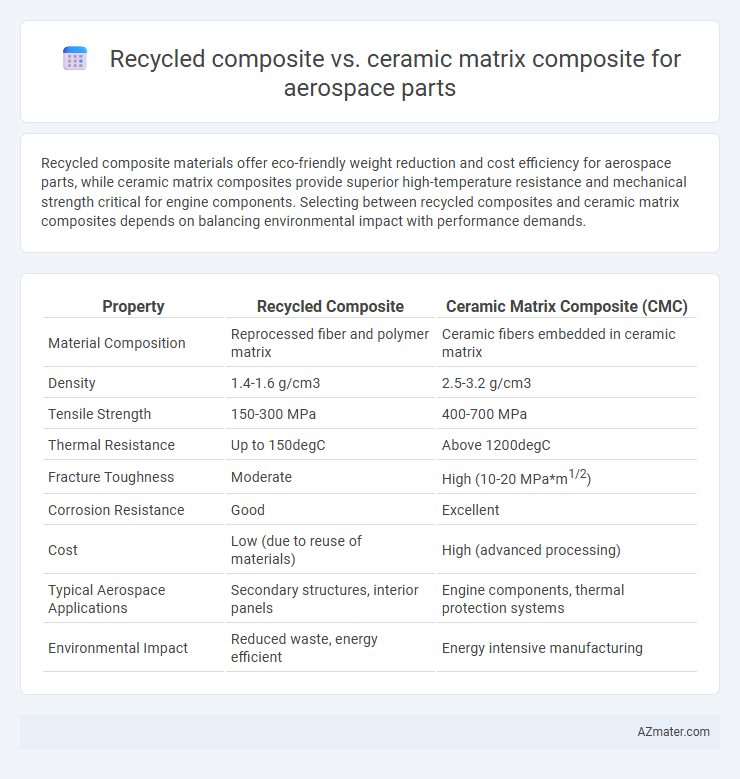Recycled composite materials offer eco-friendly weight reduction and cost efficiency for aerospace parts, while ceramic matrix composites provide superior high-temperature resistance and mechanical strength critical for engine components. Selecting between recycled composites and ceramic matrix composites depends on balancing environmental impact with performance demands.
Table of Comparison
| Property | Recycled Composite | Ceramic Matrix Composite (CMC) |
|---|---|---|
| Material Composition | Reprocessed fiber and polymer matrix | Ceramic fibers embedded in ceramic matrix |
| Density | 1.4-1.6 g/cm3 | 2.5-3.2 g/cm3 |
| Tensile Strength | 150-300 MPa | 400-700 MPa |
| Thermal Resistance | Up to 150degC | Above 1200degC |
| Fracture Toughness | Moderate | High (10-20 MPa*m1/2) |
| Corrosion Resistance | Good | Excellent |
| Cost | Low (due to reuse of materials) | High (advanced processing) |
| Typical Aerospace Applications | Secondary structures, interior panels | Engine components, thermal protection systems |
| Environmental Impact | Reduced waste, energy efficient | Energy intensive manufacturing |
Introduction to Aerospace Composites
Aerospace composites, including recycled composites and ceramic matrix composites (CMCs), are engineered to meet the demanding performance requirements of aerospace applications. Recycled composites offer sustainability benefits by reducing waste and lowering manufacturing costs while maintaining adequate strength and fatigue resistance. Ceramic matrix composites provide superior high-temperature stability, oxidation resistance, and mechanical strength, making them ideal for engine components and thermal protection systems in aerospace engineering.
Defining Recycled Composite Materials
Recycled composite materials in aerospace involve repurposing fibers and resins from decommissioned composites to create new structural components, offering sustainability and cost-efficiency. These materials maintain mechanical properties such as high strength-to-weight ratio and corrosion resistance, essential for aerospace applications. Compared to ceramic matrix composites known for thermal stability and high-temperature performance, recycled composites provide a greener alternative with adequate durability for less extreme aerospace environments.
Overview of Ceramic Matrix Composites
Ceramic Matrix Composites (CMCs) are advanced materials composed of ceramic fibers embedded within a ceramic matrix, offering exceptional high-temperature stability, low density, and superior resistance to oxidation and thermal shock. These properties make CMCs ideal for aerospace applications such as turbine engine components and thermal protection systems where lightweight materials must withstand extreme environments. Compared to recycled composites, CMCs provide enhanced mechanical strength and durability at elevated temperatures, significantly improving performance and fuel efficiency in aerospace parts.
Mechanical Performance: Strength and Durability
Recycled composites exhibit competitive mechanical performance with notable strength and durability, though they often fall short compared to ceramic matrix composites (CMCs) in high-temperature aerospace applications. Ceramic matrix composites provide superior mechanical strength, fracture toughness, and thermal stability, maintaining performance under extreme conditions critical for aerospace parts. The durability of CMCs in resisting oxidation and wear extends service life, making them preferable for components exposed to harsh environments.
Weight Considerations in Aerospace Applications
Recycled composites offer significant weight savings due to their lower density compared to traditional ceramic matrix composites (CMCs), making them ideal for aerospace parts where weight reduction is critical for fuel efficiency and performance. Ceramic matrix composites provide high temperature resistance and structural integrity but tend to be heavier, potentially limiting their application in weight-sensitive areas. Optimizing weight through recycled composites can enhance payload capacity and reduce emissions, while careful material selection ensures the balance between lightweight and durability demanded by aerospace standards.
Thermal Stability and Resistance
Recycled composites in aerospace offer moderate thermal stability and resistance, benefiting from sustainable material reuse while maintaining adequate performance under typical service temperatures. Ceramic matrix composites (CMCs) exhibit superior thermal stability, withstanding extreme temperatures above 1,200degC due to their ceramic constituents, making them ideal for high-performance aerospace parts exposed to intense heat. The enhanced oxidation resistance and low thermal expansion coefficients of CMCs outperform recycled composites, ensuring longer lifespan and reliability in demanding thermal environments.
Environmental Impact and Sustainability
Recycled composites significantly reduce environmental impact by repurposing existing materials, lowering waste, and minimizing energy consumption compared to traditional manufacturing of ceramic matrix composites (CMCs) in aerospace applications. While CMCs offer superior thermal and mechanical performance for high-temperature environments, their production involves energy-intensive processes and limited recyclability, posing sustainability challenges. The integration of recycled composites in aerospace parts supports circular economy principles by enhancing material lifecycle efficiency and reducing carbon footprint, making them a more sustainable choice for environmentally conscious aerospace manufacturing.
Cost Comparison and Production Efficiency
Recycled composites offer significant cost advantages over ceramic matrix composites (CMCs) in aerospace manufacturing due to lower raw material expenses and reduced energy consumption during production. While CMCs provide superior high-temperature performance and durability, their complex fabrication processes result in higher labor and equipment costs that impact overall production efficiency. The use of recycled composites enables faster turnaround times and scalability, making them more economically viable for large-volume aerospace components.
Real-World Applications in Aerospace Industry
Recycled composites offer cost-effective and sustainable solutions for non-structural aerospace components by reducing waste and lowering production expenses. Ceramic matrix composites (CMCs) provide exceptional heat resistance and durability, making them ideal for turbine engines, thermal protection systems, and high-temperature structural parts. Real-world aerospace applications leverage recycled composites for interior panels and secondary structures, while CMCs are used in harsh environments requiring superior mechanical performance and thermal stability.
Future Trends and Innovation in Composite Materials
Recycled composites are gaining traction in aerospace for their environmental benefits and cost-effectiveness, supporting circular economy initiatives by reducing waste and energy consumption. Ceramic matrix composites (CMCs) are advancing with enhanced high-temperature resistance and reduced weight, enabling improved engine efficiency and durability in aerospace applications. Future trends highlight hybrid approaches combining recycled polymer matrices with ceramic reinforcements, driving innovation toward sustainable, high-performance aerospace components with optimized thermal and mechanical properties.

Infographic: Recycled composite vs Ceramic matrix composite for Aerospace part
 azmater.com
azmater.com